Utah County Birders Newsletter
|
 |
Contents
July Meeting
Upcoming Field Trips
Ned's Notes
Utah County
Big Month
Bird of the Month
Backyard Bird of the Month
June Hotline Highlights
JULY MEETING:
Thursday, July 9th.
"Birds and Wildlife
Management in the Kennecott Oquirrhs"
Ann Neville has worked for Kennecott Utah
Copper since 1997. She manages the biological resources for Kennecott’s 90,000
acre holdings. This includes land use, wildlife and vegetation management and
particularly the Kennecott Inland Sea Shorebird Reserve. She participates on Rio
Tinto wide Land Use Stewardship/ Biodiversity strategies and targets as well as
global ecosystem services modeling. She is KUC’s liaison with many environmental
groups around the Salt Lake Valley. Ann is a native Utahan and obtained her
Bachelor of Science degree at Weber State and her Master’s degree in Marine
Ecology at the University of North Carolina at Wilmington.
Meet at 7:00 PM in the Bean Museum Auditorium on the BYU Campus.
July 10th (Fri) 2009:
Oquirrh mountains with Ann Neville -
This is a rare opportunity to visit Kennecott Copper property in the
Oquirrh mountains. Space is limited to 20 people. We still have 10 slots
available for anyone interested. You must pre-register by email in advance
with Lu Giddings if you wish to attend, first come first served. We still
need at least one driver with a 4wd vehicle capable of seating 5 people
including the driver. The trip will leave East Bay Sam’s Club at 7:00 am.
Please plan on carpooling with others. If you're coming from Salt Lake, Lu
will send instructions on how and when to meet.
August 2009: open
September 2009: In Search of Hungarian Partridge - Box Elder county. Details TBA
October 2009: open
November 2009: open
December 2009: Provo CBC; details TBA
We are actively recruiting people to lead local half-day field
trips, any time, any place. If you would like to lead a field trip or if you
have any ideas for this year’s field trips, please contact Lu Giddings at -
seldom74@xmission.com.
Ned’s Notes
By Ned Hill – President, Utah County Birders
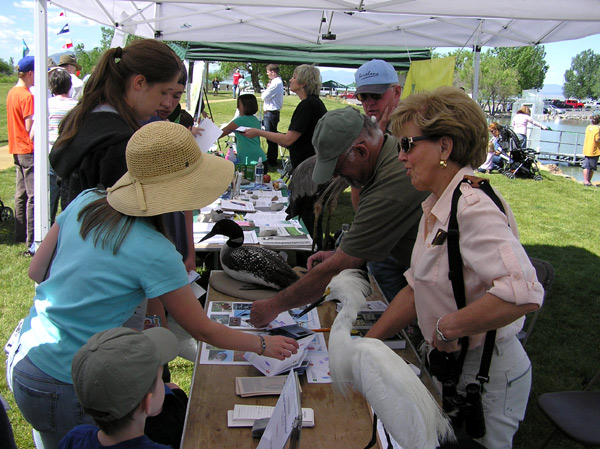 |
|
Milt Moody has manned a UCB booth at
the Utah Lake Festival the last Four years. He has put together a
presentation of the birds of Utah Lake and the surrounding area. He
and other UCB volunteers answer questions, share their knowledge and offer
field trips for festival attendees. |
“Birding Is Much More Fun
When Shared”
Seeing a new bird, “a lifer”, is a thrilling experience. I found my last life bird about 10 days ago just north of Lima, Peru—a beautiful Chestnut-throated Seedeater. But, like most of you, I think I derive just as much pleasure—perhaps even more—from sharing an old familiar bird with someone else and experiencing their excitement. There are many ways we can informally or even formally share our enthusiasm for birding and the natural world with others. Here are a few suggestions.
Make Presentations in Public Schools Teachers are always looking for people to enrich their classes. With 15 grandchildren, I have found several opportunities to go into their classrooms and share my birding experiences with young students. A couple of weeks ago, a 12-year-old granddaughter mentioned to her teacher that her grandpa could show slides of Ecuador. Since the class was doing a segment on geography, the teacher was open to my offer. I gathered up my props: a scope and tripod, Birds of Ecuador, my binoculars and a PowerPoint presentation featuring maps, photos of birds, other animals, people and places in Ecuador. They gave me an hour and had two classes (about 60 6th-grade students) attend. I showed them the slides, told them (in as dramatic a fashion as I could) about my adventures and answered their questions. I showed them photos of colorful toucans and aracaris, reclusive antbirds, stunning macaws, manakins, and hummingbirds as well as unusual insects, monkeys and reptiles. The students and their teachers seemed appreciative of learning about a place none of them had visited. And my granddaughter was even willing to admit that it could possibly have been her grandpa standing up there in front of the class.
Volunteer to Be a Counselor for the Boy Scout Bird Study Merit Badge (is there an equivalent in Girl Scouting?). This used to be a much more difficult badge to obtain but the requirements have been considerably watered down recently. Still, not many boys attempt it—probably because they don’t know of anyone who could help them. Last Friday, two young teens approached me about passing off the Bird Study merit badge. One requirement is to identify in the field 20 bird species and make notes about appearance, song, behavior, etc. On their list they had “(Species 1) Mallard, male, (Species 2) Mallard, female,” etc. So I initially—and very gently—“failed” them and told them they had to find at least four or five more species to meet the requirement. They came back Saturday morning and admitted they weren’t sure where to find more birds, so I volunteered to take them out to Utah Lake. We brought a few other friends, a scope and some binoculars and headed out to the trail that starts just north of Utah Lake State Park. We soon had a singing Western Meadowlark in the scope and the boys seemed thrilled to see this energetic songster.
Then we had a fully sunlit Yellow-headed Blackbird in the scope followed by fleeting looks at a Yellow Warbler or two. The Ospreys were on the nesting platform and cooperative Western Kingbirds and Red-winged Blackbirds let the boys have good binocular looks. We found several other Utah Lake birds before we had to head back. The boys (at least, according to their parents) had a wonderful time and may be on the way to becoming, if not active birders, at least, people who are aware of the variety of birds we have around us.
Take College Students Birding BYU (and probably other colleges and universities) mandates a biology course for all education majors that requires them to identify 75 or so birds in the wild. There are hundreds of education majors each year. So, towards the end of any semester or term you might find a few dozen semi-bewildered looking young adults wandering around places like the airport dike trying to puzzle out what bird that might be sitting in that tree. Reed Stone began helping such students informally and then even went so far as to put out a notice that he was available to help. They so appreciate the assistance and, in the process, learn how fun birding can be.
I have also interacted with college students in other ways. I make a standing offer to lead any student group to search for eagles in the winter or migrants in the spring. And each year a student service organization in the School of Management holds an auction. The students use their accumulated service hours to bid on things offered by the faculty and staff. I always offer a “morning of breakfast and birding” for four. I take them to a “gourmet” meal at a fast food restaurant and then down to the lake or other birding location. They seem to have fun and some of these students have become active birders.
Involve Your Family Of course, the most enjoyable sharing of our very interesting avocation usually comes by inviting our family to join us. For many years now, my wife and I have made it a practice of giving a grandchild who turns seven a pair of binoculars and a field guide. They also get a morning of birding to try out their gifts with grandma and grandpa. This has become a very fun and well-anticipated tradition in our family. And I think we are cultivating a number of young birders along the way.
Of course, there
are many ways you can use your own skills and network of friends and family to
share your passion for birds. And there are many rewards for making the
effort. Pre-eminent is simply the joy of helping someone else learn something
new and exciting. But we also experience a nice fringe benefit based on the
time-tested truism that we learn best when we teach. If you want to improve
your birding skills, teach someone else how to identify that little brown bird
up in that tree. When you have to explain why that bird is different from other
little brown birds, you begin to be more observant, more aware of sizes, shapes,
colors and sounds yourself.
Utah County Big Month
- June 2009
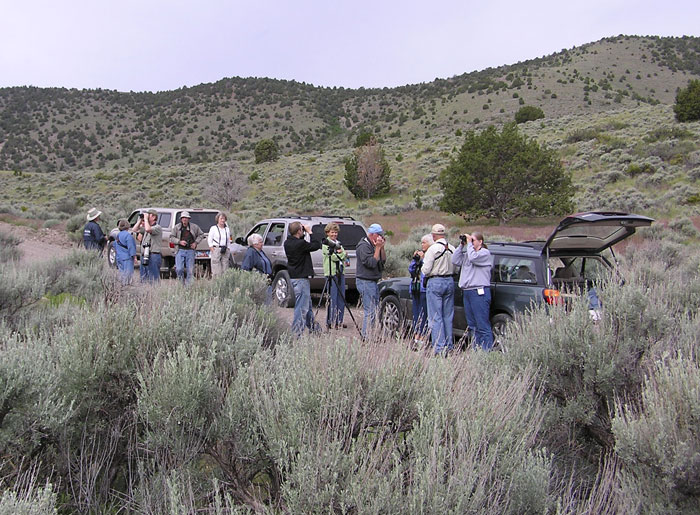 |
|
UCB birding the Tintics -
photo by Milt Moody |
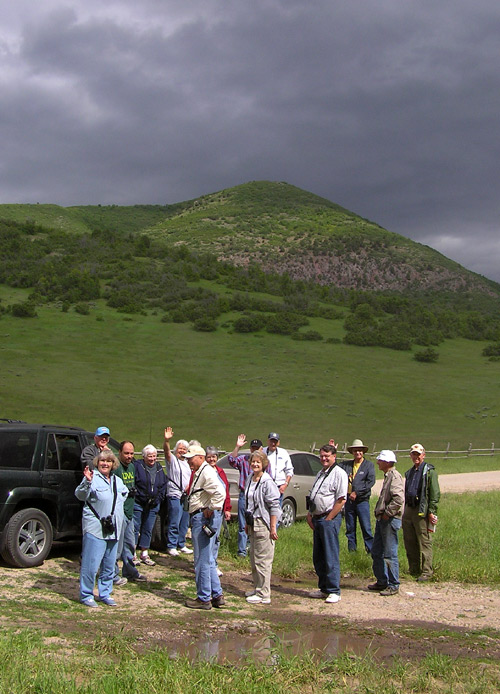 |
|
UCB birding Diamond Fork Canyon -
photo by Eric Huish |
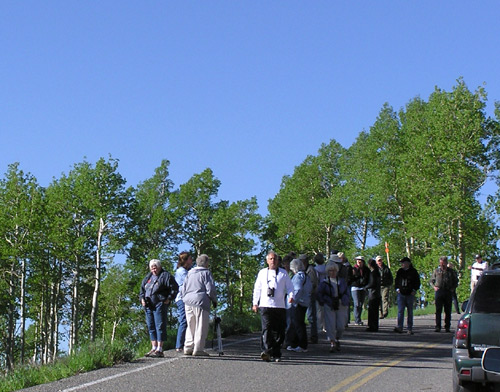 |
|
UCB birding Payson Canyon -
photo by Eric Huish |
By Dennis Shirley
About mid-June, after spending each morning birding around the County, I was
thumbing through my recently received copy of "WINGING IT", the ABA Newsletter,
when I came across an article about listing birds in your own county. How
appropriate I thought, since we were heavy into a Utah County Big Month. The
article hit the nail right on the head, listing some very apropos reasons for
birding and keeping a list in your own county. Using some of the author's
reasons and adding some of my own, here's a list and discussion of some of the
highs of the past month.
1. It was FUN! Above everything else our Big Month was fun. That's why we are
birders, because it's FUN. It was FUN to see a bunch of birds, a bunch of
birders, and bunch of either seldom visited or new areas of the County.
2. It rejuvenated our interest in the birds of our County. Those of us who have
the chance to travel to exotic birding areas in other parts of the state,
country or world, might lose sight of the great county we live in, and the birds
and birding opportunities it offers. We have a diverse range of birding habitats
to choose from, and in the diversity of birds we have here.
3. It brought together friends who don't see enough of each other. Life goes too
fast! It seems we never have enough time to spend doing what we like to do most
and to do it with the people we like to do it the most with. It was special to
have good turn outs to the field trips. One of my favorite sayings is "The world
belongs to those who show up." It certainly applies to birding.
4. Our Big Month efforts produced a number of "Good Birds." All birds are good -
well maybe with a few exceptions [house sparrow, starling]- good here meaning
rare or seldom seen in the County. These included: Common Moorhen-June 1-
Benjamin Slough, Evening Grosbeak-June 8-Payson Canyon, Long-eared Owl-June
13-East Tintic Mountains, American Three-toed Woodpecker June 16-Payson Canyon,
Lewis's Woodpecker-June 17- Diamond Fork Canyon, Green Heron- June 18- Provo
Airport dike road, Northern Saw-Whet Owl-June 21- Santaquin Canyon, Pine
Grosbeak- June 25-Santaquin Canyon, Indigo Bunting-June 28- East Tintic
Mountains, Northern Goshawk- June 29- Strawberry Ridge, Gray Vireo- June 30-
East Tintic Mountains. "Good" can mean simply a good look at a well hunted for
bird. For me "Good" birds during the month included: Bushtit [my last bird of
the month], Bewick's Wren [next to the last bird of the month], Steller's Jay,
Wild Turkey, Townsend's Solitaire, Downy Woodpecker.
5.Our Big Month made it necessary to review the preferred habitats of select
species and where they were most likely to be found in early summer [June]. I
missed Blue Grouse, Pygmy Owl, Sharp-shinned Hawk, and Lewis's Woodpecker,
because I wasn't familiar enough with the where-abouts of these species at this
time of year to be able to go out and find one. Other missed species such as
Sage Sparrow, Scott's Oriole, and Yellow-billed Cuckoo, were not located, even
though they are in the county somewhere, I believe, because we just don't know
exactly what the birds need to exist and where to look. I continue to be stumped
trying to find a Scott's Oriole in the County and also a breeding population of
Sage Sparrows.
6. Even County Birding produces "Chasers." It did my heart good to hear about
the number of bird chases that went on during the month. I thought Carol Jean
was following me around, as many times as we ran into each other in far out
places. Eleventh hour birds included the Gray Vireo for Cheryl, Canyon Wren for
Carol Jean, and Wild Turkey for Alton at10:30pm on the 30th in a roost tree in
the South Fork of Provo Canyon and this was after a quick trip out to get the
Gray Vireo in the Tintics before dark. Now if that isn't FUN I don't know what
is!!
7. A Big Month, Day, Year, or what-have-you, always creates bird surprises. Some
birds show up when least expected. Such was the case of the Indigo Bunting. I
had looked for them in every place where they had been seen in other years in
the county, riparian areas, hedgerows, willow bottoms, only to find one in the
most unlikely spot - sage/juniper slope on the Tintic Mountains foothills. Some
surprise late/lingering migrants included, Black-bellied Plover, Common
Goldeneye, Ring-necked Duck, and Wilson's Warbler. Possible early fall migrants
which were not seen, but are expected any day included, Rufous Hummingbird, and
shorebirds, including especially Solitary Sandpiper.
8.Birding should be carefree and provide an outlet for the sometimes stressful
world we live in. I'm not sure chases at the most inopportune time fits this
bill. At least in a county it's usually not as far as say the
entire State, or worse the Country. Tell me there's no stress when it's getting
dark on the last day of the Big Month and you still haven't seen a wild turkey.
Our Big Month has been all of the above in one way or another. It's been
rewarding to those who got into the spirit of it and gratifying in every sense
of the word. I think if all the lists were put together it would be darn close
to 200 for the month, at least in the 190's for sure. Maybe next year again!
------------------------------
Big Month Participants
Dennis Shirley – 186
Merrill Webb – 180
Alton Thygerson – 168
Ned Bixler – 166
Carol Nelson – 163
Cheryl Peterson – 156
Yvonne Carter – 153
Leila Ogden – 145
Alona Huffaker – 140
Milt Moody – 135
Bonnie Williams – 131
Nathan Romney – 127
Eric Huish – 117
Oliver Hansen – 95
Ned Hill – 36 ( but 464 in Peru)
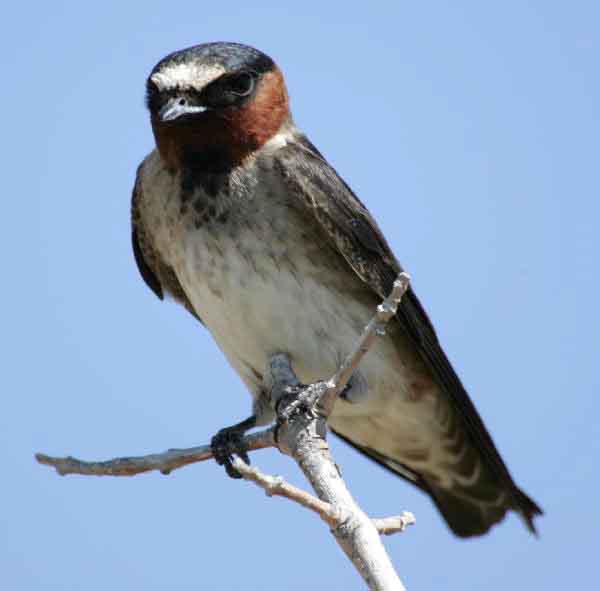 |
|
photo by
Jack Binch |
Bird of the Month
Cliff Swallow
Petrochelidon pyrrhonota
By Alton Thygerson
Farmers should welcome this bird because it eats numerous flying insects that
are harmful to crops. While Cliff Swallows were once listed as being of special
concern for being endangered, they have successfully adapted to nesting on
man-made structures such as highway bridges and overpasses and buildings. Most
of us can recall seeing their mud nests attached to a bridge or highway
overpass.
One of the most impressive colonies I’ve witnessed was near Woodruff in Rich
County. One side of an old dilapidated wooden barn was covered by hundreds of
nests. Cliff Swallows construct a complex nest—a sphere of mud pellets with a
tubular entrance on one side. The gourd-shaped mud nests can number up to
several hundred or thousand in a single location. Since their nests are made of
mud, the birds are found near water.
Their plastering of nests to an office building can raise the ire of a
building’s owner. Several years ago a colony attached their nests to my office
building, and one morning when I arrived a “demolition” crew had just completed
tearing down the nests. The swallows where flying erratically around and
appeared distressed. I immediately called the maintenance supervisor and issued
a complaint about the tearing down of migratory bird nests. His defense was that
there were no eggs in any of the nests.
Swallows and their nests are fully protected under the Migratory Bird Treaty Act
of 1918, which makes it illegal to intentionally kill, injure or take any
migratory bird. It is illegal to intentionally damage or destroy the nest, eggs,
or young of a swallow while it is being built or in use. The Act allows fines or
prison sentences for every bird, egg or nest destroyed. There are legal ways of
removing unwanted nests.
An interesting Utah County Birders meeting would be a presentation on some of
the laws (migratory, hunting, endangered species, etc.) protecting the feathered
creatures we enjoy watching.
Migration: All Cliff Swallows retreat to South America well before the onset of
winter. Some birds depart in early July and most have left the United States by
the end of September.
This is the famous swallow that returns to the mission in San Juan Capistrano,
California, every spring. While their return is celebrated on March 19th the
birds actually return to the general area and along the other border states in
late February. Those nesting in Alaska may not arrive until May.
Similar Species: Barn and Cave Swallows. Cliff Swallows occasionally nest with
Barn Swallows and, in Texas, Cave Swallows. Utah does not have Cave Swallows.
Description: This bird is easily identified. Despite some plumage similarities,
you cannot mistake this species with its square-tipped tail for a Barn Swallow
which has a deeply forked and longer tail.
It can be told from all swallows except the Cave Swallow (not found in Utah) by
its buffy rump and squared tail and dark throat. The Cliff Swallow’s pale spot
on its forehead resembles a miner’s lamp.
In flight, concentrate on the buffy or rufous-colored rump which is easier to
see than the pale forehead. The buffy rump contrasts sharply with the bird’s
dark back and tail. This bird glides more frequently than other swallows (except
Purple Martin and Violet-green). It ends each glide with a roller coaster-like
climb.
Of all the swallows, except the Barn Swallow, Cliff Swallows have the most
extensive breeding range of all North American swallows. Therefore, get to know
this bird because it appears across most of the United States but more
frequently in the west.
June 2009
Leena Rogers – Provo
Brown-headed Cowbird – the first time for this species in my yard.
Bonnie Williams – Mapleton
A pair of California Quail with 5 babies.
Steve Carr - Holladay
Downy Woodpeckers - One nesting pair in the yard and another nearby.
Milt Moody - Provo
Juvenile Spotted Towhee - it was mainly dark brown with light speckles
and a very long black tail with white in the end corners.
Eric Huish – Pleasant Grove
Western Screech-Owl - 1 adult and 4 owlets in an aspen near the nestbox.
Dennis Shirley – Elk Ridge
I haven't been in my back yard all month, but everywhere else in the county!
PS. Lesser Goldfinches
Yvonne Carter - Highland
The Bullock's Orioles are sure taking over my hummingbird feeders! I have
watched them climb all over the feeders and even knock them to the ground.
We would like you to share your favorite backyard bird each
month. Please send your favorite bird at the end of the month to
newsletter@utahbirds.org or call
Cheryl Peterson at 375-1914 (home) or 787-6492 (cell).
We are accepting
2009 dues for membership in Utah County Birders throughout the 2009 season.
If you would like to be an official member of our group and receive a handheld
copy of the newsletter, do the following:
Make a check out to Utah County Birders for $15.00.
Put it in an envelope addressed to:
Carol Nelson
2831 Marrcrest West
Provo, Utah 84604
Then, drop it in the mail. And as always, thanks for your support and a
special thanks to those we never see, but who still show their support by their
dues donations!